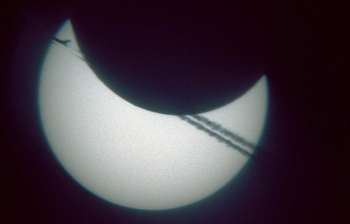Credit: Edward Hanna
A pioneering study by the University of Sheffield has revealed the meteorological impact of the 2015 UK solar eclipse across three countries.
The analysis of high-frequency surface air temperature, mean sea-level pressure, wind speed and direction and cloud-cover data from the solar eclipse of 20 March 2015 from the UK, Faroe Islands and Iceland, published today (Monday 22 August 2016), sheds new light on the phenomenon.
The research, led by Professor Edward Hanna, of the University of Sheffield's Department of Geography, used data from 76 UK Met Office weather stations, 30 weather stations in the Faroe Islands and 148 stations in Iceland.
It found:
- There was a statistically significant mean UK temperature drop of 0.83±0.63 degrees Celsius, which occurred over 39 minutes on average, and the minimum temperature lagged the peak of the eclipse by about ten minutes.
- For a subset of 14 relatively clear (cloudy) stations, the mean temperature drop was 0.91± 0.78 (0.31±0.40)degC, but the mean temperature drops for relatively calm and windy stations were almost identical, indicating that cloud cover has a much greater effect than wind on the air temperature's response to an eclipse.
- The average wind speed dropped significantly by 9 per cent on average during the first half of the eclipse, in line with previous studies.
- There was no detectable effect of the eclipse on the wind-direction or barometric pressure time series, and therefore we can discount any localised change in air circulation over Britain (for example, the much-fabled 'eclipse cyclone') during this event.
- Similar changes in air temperature and wind speed were observed for Iceland, where conditions were generally clearer, but there is no evidence of the eclipse cyclone.
- In the Faroes, there was a much more muted meteorological signature.
The study represents a successful co-operation between the University of Sheffield, the UK Met Office, the Icelandic Met Office, the Danish Meteorological Institute and the Faroe Islands Met Service.
It is published in a theme issue of Philosophical Transactions of the Royal Society A, co-edited by Professor Hanna and Professor Giles Harrison, from the University of Reading, which highlights studies of the 2015 eclipse on atmospheric phenomena from the surface to the ionosphere, using data from weather stations, balloons, satellites and weather prediction models.
Professor Hanna said: "This theme issue contains a valuable collection of papers on the meteorological effects of a solar eclipse, and takes advantage of the fact that the 20 March 2015 eclipse crossed a densely populated and instrumented part of the Earth's surface, allowing a unique set of meteorological measurements to be obtained using modern, state-of-the-science instruments: especially accurate and sensitive automatic weather stations measuring temperature, wind and pressure at high time-frequency.
"Our contribution brings together high-quality professional meteorological datasets from the UK, Faroes and Iceland, and has enabled variations in the surface air temperature and wind in response to the eclipse to be effectively tracked through space and time over a wide (sub-continental) region. Very few, if any, such studies of this geographic scope have previously been published."
He added: "A substantial solar eclipse, as occurred over Northwest Europe on 20 March 2015, provides an excellent opportunity for natural meteorological experiments, such as the ones reported here. However, there will not be another solar eclipse of comparable magnitude in the UK until 2026, so it is vital to take advantage of these relatively rare chances."
Professor Sir Arnold Wolfendale FRS, 14th Astronomer Royal, said: "Until recently, solar eclipses were eagerly studied by astronomers from the standpoint of examining the sun's 'corona'; history is replete with stories of astronomers making heroic journeys to gain the site of maximum visibility. Often, alas, cloud precluded the spectacle, and the sun preserved its mystery.
"The boot is now on the other foot, with satellite studies making solar studies 'easy' and interest shifting to meteorological aspects. The heightened importance of climate change leads to great interest in a variety of climate parameters which can be studied when, uniquely, 'the power is switched off'. The present volume of papers relates to both the scientific and the personal aspects of the awe-inspiring phenomenon of the solar eclipse."
Journal information: Philosophical Transactions of the Royal Society A
Provided by University of Sheffield























